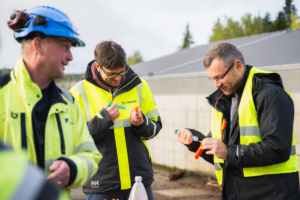By implementing effective standards and emphasizing energy-efficient solutions, cooling systems can significantly reduce climate change and improve energy efficiency.
SINTEF is participating at COP as an independent observer, committed to advancing sustainable climate and energy solutions. To support this goal, we are providing advice to climate negotiators on 15 key areas with the potential to significantly reduce emissions.
Recommendations for sustainable cooling
- Prioritise the development and implementation of efficient and competitive cooling systems with natural refrigerants, such as CO2, ammonia and hydrocarbons, which are long-term and climate-friendly solutions without unwanted health and environmental effects.
- Restrict the use of refrigerants with a global warming potential over 150, and ban fluorinated refrigerants that fall under the definition of perfluorinated substances, to avoid unwanted effects on the environment or human health.
- Support the development of standards that allow for higher charge limits of hydrocarbons in heat pumps and cooling systems, for efficient decarbonisation of heating and cooling in buildings.
- Invest in the development of high-temperature heat pumps with natural refrigerants. This can cover heating needs in industry between 100-200°C, and be a key component in the decarbonisation of industrial processes.
- Implement sustainable cooling and heating solutions throughout the food value chain to promote energy-efficient solutions and avoid food waste.
- Develop technical solutions for heat pumps that can displace the use of fossil heat sources in buildings and industry.
Problem
Sustainable cooling was raised as an important topic by COP28’s presidency, and remains relevant during COP29. According to the UN Environment Programme (UNEP), a sustainable strategy for cooling is crucial for managing climate change, as energy efficient cooling is important for both climate adaptation and reducing greenhouse gas emissions. Moreover, global warming and increasing extreme temperatures will lead to an increased need for cooling.
Chlorofluorocarbons (CFCs) are a group of odourless and artificially produced chemicals. In the past, they were commonly used in spray cans, refrigerators, air conditioners, and a variety of other products. However, it was discovered that these chemicals were contributing to the destruction of the ozone layer. As a result, countries came together to introduce a global ban on the use of CFCs through the Montreal Protocol, which entered into force in January 1989. The replacement was largely hydrofluorocarbons (HFCs), which do not have ozone-depleting properties, but have since been shown to be very powerful greenhouse gases. In January 2019, the Kigali Amendment to the Montreal Protocol entered into force, which entails a gradual reduction of HFC consumption. By switching to ozone- and climate-friendly alternatives, we can avoid increasing the global temperature by more than half a degree by the end of the century.
A new concern has arisen in recent times related to replacement substances for HFCs, so-called hydrofluoroolefins (HFOs), which have a low global warming potential (GWP) but fall under the category of perfluorinated substances (PFAs). They break down in whole or in part into trifluoroacetic acid (TFA), which later accumulates in nature as “forever chemicals”. This can have many possible negative effects on human health and the environment. There are currently no restrictions on these substances, but Norway, Germany, the Netherlands, Denmark and Sweden have proposed phasing out these substances. A clarification from the European Chemicals Agency (ECHA) is expected in 2025 at the earliest.
Cooling also requires energy, and its sustainability depends on the source of that energy. While cooling based on renewable energy is environmentally friendly, in areas that produce power based on fossil sources, cooling will indirectly produce significant climate emissions. It is therefore crucial that all cooling systems have the highest possible energy efficiency. This includes not only ensuring that components and systems have a high energy efficiency, but also utilising surplus heat and reducing the need for cooling and heating to the greatest extent possible.
Solution
According to the UNEP, meeting cooling needs in a sustainable way could help over a billion people with climate adaptation, and reduce the costs associated with transitioning from fossil fuels to renewable energy sources by an estimated $3.5 trillion by 2030.
SINTEF and NTNU have world-leading expertise in sustainable and renewable cooling, with a particular emphasis on natural refrigerants, naturally occurring in the biosphere. Use of such refrigerants would provide a long-term and climate-friendly solution that can withstand future challenges, without the risk of unexpected negative impacts on the environment or human health. Many countries can transition directly from hydrochlorofluorocarbons (HCFCs) and HFCs to sustainable alternatives without needing temporary mediary solutions that need to be phased out in a few years.
We must also develop technologies for heat pumps and cooling systems that can replace fossil heat sources for space heating or industrial processes. Hydrocarbons (HCs) and other natural refrigerants are very well suited for this purpose, but refrigerant charge is limited by current standards, particularly for flammable refrigerants. In order to exploit this potential, we need to develop new standards that allow larger charges. In addition, emphasis should be placed on integrating systems that utilise excess heat, which can further reduce energy demand and further improve the overall energy efficiency.
In addition to replacing potent greenhouse gases and direct emission cuts, natural refrigerants can also contribute to energy savings. Supermarkets that use CO2 as a refrigerant can reduce their electricity consumption by approximately 35% by integrating the needs for refrigeration, freezing, heating and indoor climate cooling in the same facility. More than 85,000 such facilities are estimated to have been installed globally.
Another example is fishing vessels that need to cool or freeze the fish they catch. Simple, efficient refrigeration systems can save a lot of food, which is needed for a growing population. A large proportion of the global fishing fleet still uses HCFC-22, which has a significant detrimental effect on both the ozone layer and global temperatures. HCFCs are also used for long-distance transport of refrigerated goods (reefer containers). Developing and adopting efficient cooling systems that use CO2 instead, has a great potential as an alternative.
Main COP29 recommendation: International research communities and industrial partners are developing technologies to reduce emissions and advance the energy transition, and we strongly recommend establishing a global North-South R&D program with open, competitive calls to ensure a fair, accelerated path to a sustainable economy.










Comments
No comments yet. Be the first to comment!